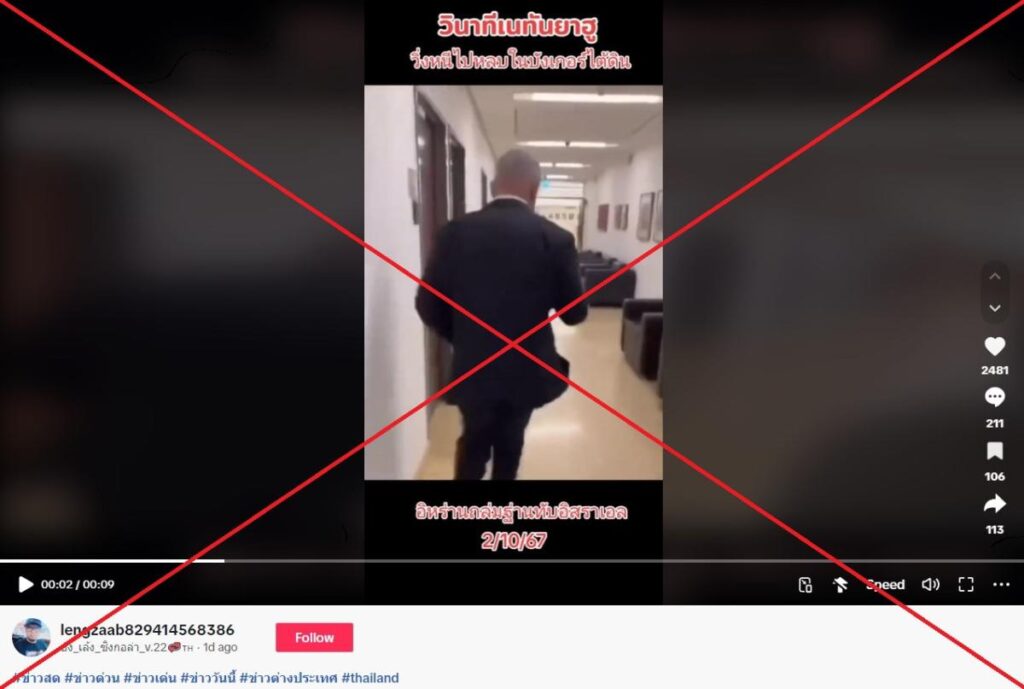A recent viral video purporting to show Israeli Prime Minister Benjamin Netanyahu fleeing to a bunker during a missile attack by Iran has been widely shared across social media. This misleading portrayal gained traction following Iran’s military response to its grievances with Israel, indicating a chaotic and dangerous situation for the Israeli leader. The TikTok post in question, which surfaced on October 2, 2024, has been accompanied by Thai-language text that claims to depict the moment Netanyahu was fleeing to shelter following the supposed attack on October 1, 2024. However, the clip is actually a three-year-old video from a parliamentary session, demonstrating how misinformation can misrepresent real events to create a false narrative.
The origins of the video trace back to December 14, 2021, when it was initially posted by Netanyahu’s official social media account. On that occasion, the video showcased Netanyahu’s hasty movement within the Knesset, the Israeli parliament, as he rushed to participate in a vote. The post highlighted his commitment to serving the Israeli populace, stating, “I’m always proud to run for you.” Thus, the timing and context of the video had nothing to do with recent military tensions but were rather reflective of the parliamentary process. This illustrates the critical importance of verifying the accuracy of social media content, especially during times of heightened political and military conflicts.
Iran’s military activities were prompted by Israeli air strikes that targeted Iranian assets, including an Israeli airstrike in April that destroyed the consular annex of the Iranian embassy in Damascus, which resulted in significant casualties. These attacks marked a shift in military aggression, as Iran previously launched a large-scale attack involving over 300 drones and missiles against Israel. The context surrounding the current misinformation not only highlights the fraught political atmosphere but also emphasizes how emerging conflicts can easily become entangled with disinformation, further complicating public understanding and responses.
The initial response to these attacks has seen devastating consequences. Reports following Hamas’s October 7 attack on Israel revealed significant loss of life, with at least 1,206 individuals, primarily civilians, confirmed dead. Amid these developments, over 251 people were abducted, many of whom continue to remain missing while others have been confirmed dead. In what has become a dire humanitarian crisis, Israel’s military counteroffensive has been marked by excessive casualties, with estimates suggesting more than 42,000 fatalities in Gaza, the majority of whom are civilians, as reported by health officials in the region.
Amid the turmoil and heightened tensions, misinformation continues to circulate, often spreading rapidly across various platforms and languages. The video of Netanyahu has been disseminated in multiple languages, extending its reach and reinforcing false narratives around the ongoing conflict. This phenomenon showcases the power of social media as a double-edged sword—while it can disseminate information quickly, it can just as easily spread falsehoods that can exacerbate already volatile situations. Efforts to debunk this misinformation, including previous attempts by outlets like AFP, highlight the need for critical consumer awareness regarding the information shared on social media, particularly in relation to political leaders during crises.
The persistent cycle of misinformation and media manipulation surrounding figures such as Netanyahu serves as a valuable lesson on the importance of source verification and context in news reporting. As political circumstances evolve and military conflicts take center stage, discerning the accuracy of shared information becomes increasingly vital for both public understanding and policy discussions. The challenge remains for social media users to navigate this complex landscape effectively and maintain an informed perspective on the global events that shape the geopolitical landscape, especially in regions marked by ongoing violence and strife. This awareness is crucial for fostering informed discussions and encouraging accountability in the portrayal of political happenings.

